What Genres of Art Were Popular in Northern Europe During the Baroque Period?
The Baroque period developed after the Renaissance and Mannerism art periods. Information technology brought with information technology new perspectives most life, art, faith, and culture. The Baroque style moved away from the severe elements depicted past the Protestant style. The Catholic Church supported the development of Bizarre with its origins in Rome, Italy, and eventually in European countries like northern Italian republic, France, Spain, Portugal, Austria, southern Germany, and Russia. Below, we discuss this decorative and fanciful art period.
Table of Contents
- i Historical Foundations: When Was the Bizarre Period?
- ane.1 The Reformation: The Catholic Church building and Protestants
- one.two Protestants versus Counter-Reformation Developments
- i.iii A Flawed Pearl: Definition of Baroque
- 2 What Is Baroque Art?
- ii.1 Baroque Art Characteristics and Techniques
- iii Famous Bizarre Artists
- 3.i Baroque Paintings
- three.two Baroque Architecture
- iii.3 Baroque Sculpture
- four Other Famous Baroque Painters
- 4.ane Flemish Baroque Artists
- 4.ii French Baroque Artists
- 4.3 Spanish Baroque Artists
- 4.4 Dutch Baroque Artists
- 5 From Dark to Light: Bizarre and Rococo
- 6 Oftentimes Asked Questions
- half-dozen.1 What Is Baroque Fine art?
- half dozen.2 What Characterized the Baroque Period?
- 6.three When Was the Baroque Period?
Historical Foundations: When Was the Baroque Flow?
The Baroque flow began during the the late 1500s until the early on 1700s, and was wide and varied throughout Europe. Its principles of extravagance, ornateness, and decorated details were portrayed in a range of cultural mediums like paintings, compages, sculpture, literature, and music. It was a menstruation of revival in art and culture with deep roots in the religious structures and powers of Western Europe at the time, which was the Catholic Church building, and presently referred to as the Roman Catholic Church.
Bizarre art of any kind was inseparably linked to the Cosmic Church. In fact, the Church informed what art should look similar in lodge to accept a desired result upon the people. It was made to inspire grandeur and awe in the people who experienced it, and became a wholly new sensory experience.
The Catholic Church backed the Baroque mode because information technology needed a new and enlivened arroyo to inspire and uplift the mutual people over again, every bit well as to connect them with the Church and its majesty. After the turmoil of war and conflicts from the Reformation, this was a refreshing resurgence for the Church building.
The driving forces backside this can exist considered propagandist, equally it used the modes of visual representation and communication (painting, architecture, sculpture) in order to maintain the credibility and authority of the Catholic Church building.
To understand the advancements that Bizarre Art brought to art and civilisation, we need to await at the historical foundations underpinning this flow.
The Reformation: The Catholic Church and Protestants
The Bizarre menstruum adult from considerable political and religious upheaval in Europe, such as the Reformation between the Protestants and Catholic Church during the 1500s. Although the Reformation may have started with many other religious figures before Martin Luther (a German monk, priest, and theologian), many scholarly sources point to him every bit the catalyst of the Reformation, which set these events in motion.
Martin Luther is known for his publication entitled, "95 Theses", which he wrote in 1517 out of apprehension about various questionable actions by the Catholic Church. His apprehensions were primarily most the Church (under Pope Leo X) selling indulgences, otherwise known as plenary indulgences, to people to raise coin to build St. Peter's Basilica in the Vatican City of Rome.
Indulgences were well-nigh similar certificates guaranteeing people that they would go to Heaven and spend less fourth dimension in Purgatory if they offered donations to the Church building, did a good deed, visited a certain place, or recited a prayer. In this example, the financial donations helped the Pope build the Basilica. Martin Luther did non agree with this type of process, as he believed no 1 needed to pay for their identify in Heaven. Furthermore, he had other deeper concerns most the Church and its stance on various religious matters relating to the Catholic Sacraments.
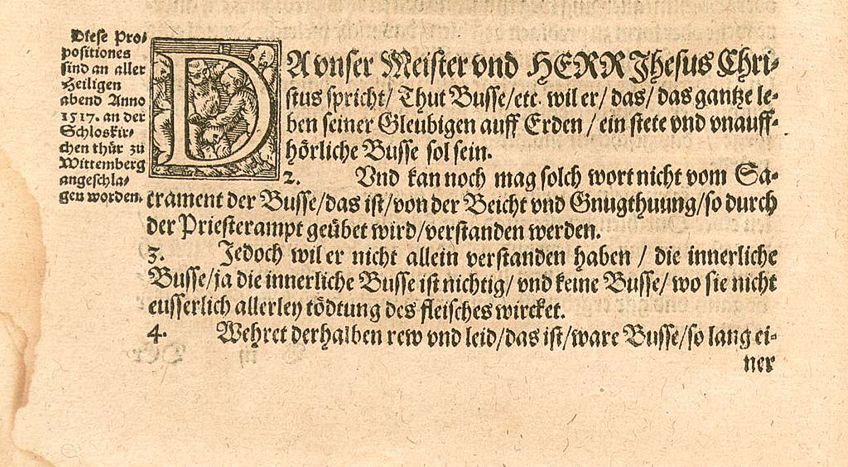 Beginning of the text of the beginning printing of the German version of the 95 Theses in 1557;Martin Luther, Public domain, via Wikimedia Commons
Beginning of the text of the beginning printing of the German version of the 95 Theses in 1557;Martin Luther, Public domain, via Wikimedia Commons
During this time, Martin Luther taught Moral Theology at Wittenberg University and he was also a preacher. He heard about the information that indulgences were beingness sold, and was made enlightened of sermons existence given near Wittenberg by another preacher called Johann Tetzel, a German language Dominican preacher who was also the Grand Commissioner for indulgences.
Martin Luther sent the "95 Theses" to the Archbishop of Mainz, who was Albert of Brandenburg at the time, to inform him well-nigh what was happening. He besides posted it on church building doors in Wittenberg, which was a mutual exercise to practise. The availability of the printing press allowed Martin Luther to make numerous copies of his publication. In fact, hundreds were printed in Germany, as well as translated to German from Latin. The certificate somewhen landed in the easily of many respected intellectuals.
It was in 1521 when Martin Luther came to stiff disagreements with the Church, equally he would not renounce his views when asked to. Considering of this, he was denounced from the Church and considered a "notorious heretic" in the Edict of Worms, declared by Emperor Charles V.
After the turn of events from the Reformation, which was believed to accept ended either during the Peace of Augsburg in 1555 or during the Treaty of Westphalia in 1648, the Catholic Church formed a Counter-Reformation. This started during 1545 to 1563 with the Council of Trent. The Council of Trent consisted of many meetings addressing various bug and procedures nowadays within the Church building and its systems.
Protestants versus Counter-Reformation Developments
The Counter-Reformation also sparked new developments in art and spirituality. The Protestants sought to exercise away with a lot of the Catholic Church's religious imagery, agreeing that information technology was as well improvident. Some Reformists violently destroyed the Catholic Church building'southward religious imagery, known as iconoclasm. The Protestants believed religious images should only depict Jesus or images of the cross, in line with Protestant values.
As a response to the astringent styles depicted in Protestantism, the Cosmic Church building believed religious imagery held a lot of power. Furthermore, during the events of the Council of Trent it was decided what religious imagery would be acceptable or not. The "pastoral function" of art was considered a master purpose of religious imagery, pregnant that artists could depict the stories of Christ's suffering, crucifixion, and many of the saints related to Biblical stories. The council members made strict rules that all imagery could not comprise any idolatrous innuendos.
What followed were new artistic styles and attitudes depicted in religious imagery, amend known as the Baroque period.
A Flawed Pearl: Definition of Bizarre
By understanding the meaning of the term "Baroque", we volition proceeds more context about what Baroque art stood for and was. The art developed during this fourth dimension was the visual result and achievement borne from deeper historical, social, and political issues in Europe. It was an historic period of discovery undoubtedly, introducing new concepts and techniques within the art world, and hence, an accomplishment.
The term baroque has been understood within various contexts. Information technology is a French discussion, but its root origin is traced to the Portuguese barocco, which ways "a flawed pearl". This term was related to jewelry equally early every bit the 1500s onwards. It was used to draw the shapes of real pearls.
There are other definitions of the term that chronicle to philosophy, specifically logic, or Aristotelian Logic. As a Latin term, baroco, information technology was used to help with remembering syllogisms, which were used in deductive reasoning formulas. Several scholars and philosophers practical this discussion beyond the school of logic, for example, Michel de Montaigne defined information technology equally "bizarre and uselessly complicated".
 La Visite à la one thousand-mère('Visit to Grandmother', c. 1645-1648) by Louis Le Nain;Louis Le Nain, Public domain, via Wikimedia Commons
La Visite à la one thousand-mère('Visit to Grandmother', c. 1645-1648) by Louis Le Nain;Louis Le Nain, Public domain, via Wikimedia Commons
Jean-Jacques Rousseau, a philosopher and musician in the 1700s, described Baroque music as beingness disharmonious in the Dictionnaire de musique ('Dictionary of music', 1768), stating, "Bizarre music is that in which the harmony is confused, overcharged with modulations and dissonance. The song is hard and unnatural, the intonation difficult, and the motility constrained. It would seem that this term comes from the baroco of the Logicians".
Heinrich Wölfflin, an art historian from Switzerland, described "baroque" inside the context of beingness an art manner in his publication Renaissance und Barock (1888). In whichever manner this term has been defined over the centuries, the underlying essence certainly conveys a sense of imperfection, confusion, and mayhap even disorder and beauty.
This is evident in the Bizarre manner, whether it exist paintings, sculptures, compages, music, or literature. Below, we take a closer await at what Baroque Art is.
What Is Baroque Art?
Baroque Art was pioneered by noteworthy painters, architects, and sculptors who brought the visual ability of art to the masses. There were many important figures for the Baroque period. For example, artists like Caravaggio, who portrayed strong realism in his paintings, the Carracci brothers and their Bolognese School, which sought to move away from the art of Mannerism (the art period later on the Renaissance), and Giacomo Della Porta, an Italian architect. We will expect at these artists and their contributions to the Baroque style in greater detail below.
Bizarre Fine art Characteristics and Techniques
What fix the Baroque flow apart from the Renaissance and subsequent Mannerism periods was its focus on more liveliness in its subject matter and a stark realism. Some sources also describe it as focusing on the moment the upshot is taking place, or otherwise the "action" or drama. The subject matter was of religious and biblical narratives, equally instructed by the Catholic Church building. These would range between images of the Virgin Mary, the various Saints, and various stories from the Bible.
Furthermore, Baroque paintings were characterized by the utilize of vibrant colors applied with swirling and wide brushstrokes, which indicated move and emotional intensity. This painting style focused on depicting big expanses of light and openness, which was besides seen in compages, such every bit the churches with expansive areas within the heart of the building, capped past cupolas (domes or square-like crowning structures over a roof) in a higher place for more light to enter the edifice.
Chiaroscuro
Chiaroscuro is an Italian term that means "light-dark". It focuses on defining contrasts in painting. This technique started in the Renaissance period, but it was the style Caravaggio utilized it that information technology became a popular feature of the Baroque period. With the potent accent on dark and light within his compositions, the viewer about becomes a part of the event portrayed in the painting.
An case includes Caravaggio'due southThe Calling of St. Matthew (1599 – 1600), where we run across the correct finger of Christ pointing towards St. Matthew. The light and shadow on the wall from the incoming sunlight is directly echoed aslope Christ's pointing finger.
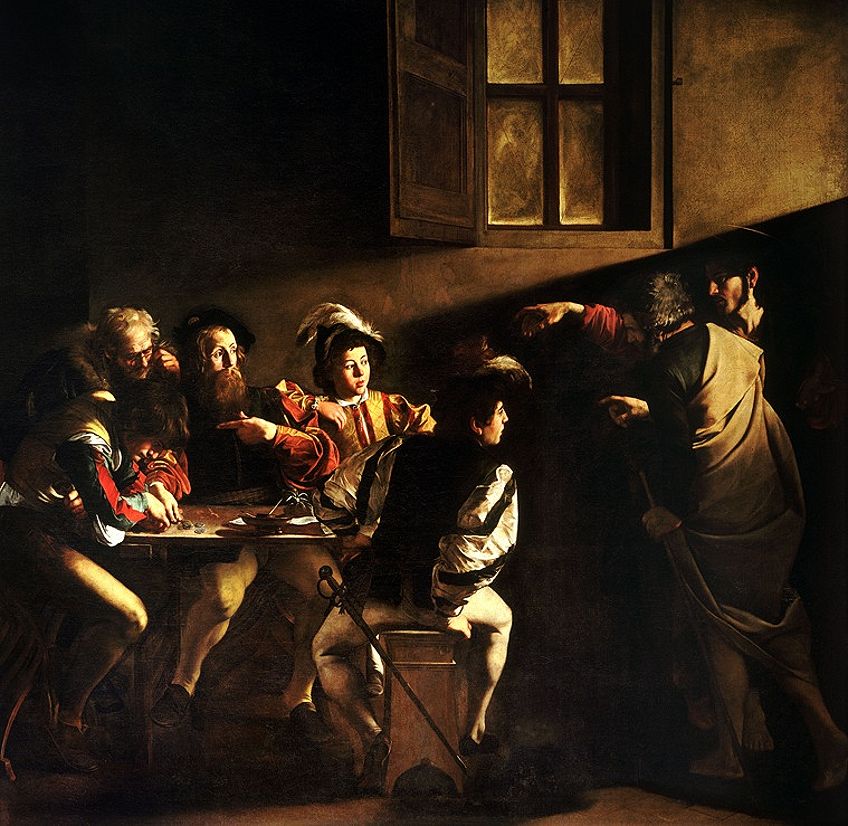 The Calling of Saint Matthew(1599-1600) past Caravaggio;Caravaggio, Public domain, via Wikimedia Commons
The Calling of Saint Matthew(1599-1600) past Caravaggio;Caravaggio, Public domain, via Wikimedia Commons
Tenebrism
Tenebrism was some other technique used by several Baroque painters, popularized and believed to have started by Caravaggio. Although it is like chiaroscuro, it mainly focuses on the darker areas of a painting. The term originates from the Italian word, tenebroso, which in plow originates from the Latin, tenebra, pregnant "darkness". Other words related to this terms are gloomy and mysterious. It sought to create what is referred to as the "spotlight" event, as well chosen "dramatic illumination".
Quadro Riportato
Quadro Riportato means "carried picture" in Italian, and information technology was used equally a technique by which the artist would paint what appeared as a frame around a painting, which would consist of a serial of paintings displayed as a fresco. This technique was used by ane of the forerunners of the Bizarre period, Annibale Carracci. Information technology is evident in The Loves of the Gods (1597 – 1600) fresco on the Farnese Palace's ceiling.
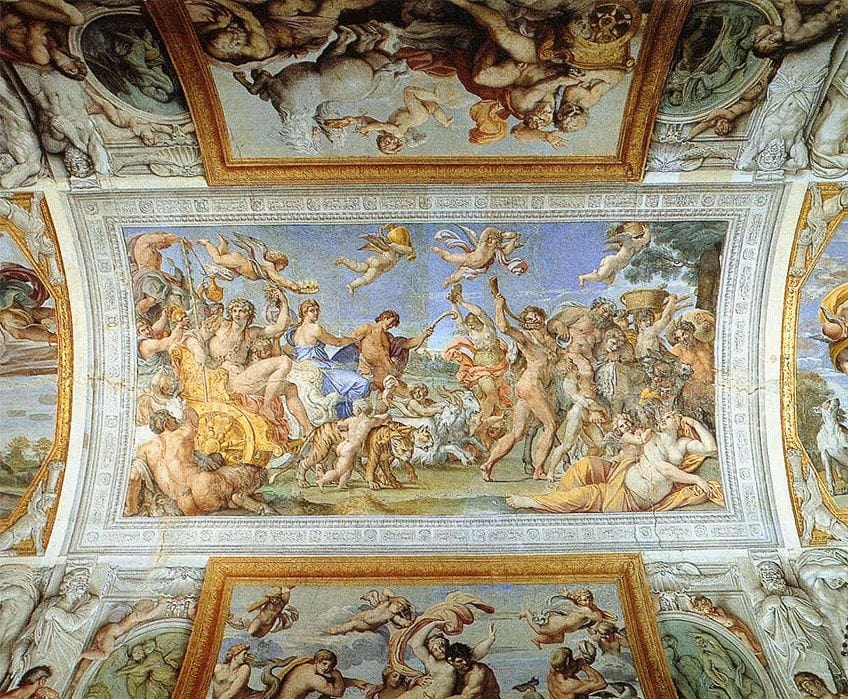 Carracci's Triumph of Bacchus and Ariadnedepicted in the center of The Loves of the Gods (1597-1600) fresco on the Farnese Palace's ceiling; Annibale Carracci, Public domain, via Wikimedia Commons
Carracci's Triumph of Bacchus and Ariadnedepicted in the center of The Loves of the Gods (1597-1600) fresco on the Farnese Palace's ceiling; Annibale Carracci, Public domain, via Wikimedia Commons
Illusionism: Trompe fifty'Oeil and Quadratura
The idea of "opening up" spaces within paintings was a large part of Bizarre Art, as this besides gave the sense of it being an optical illusion with the painted image appeared three-dimensional. Creating this three-dimensionality was known equally trompe l'oeil, which means "deceive the eye" in French.
We can run into this on many of the frescos in churches and paintings throughout the Baroque flow. However, it did not start during this art period and can instead be establish dating back as early as the 1800s. In fact, this technique was used equally early equally some Greek mural paintings as well as far into futurity with artists like Salvador Dali, who utilized this technique in his Surrealist paintings.
Baroque artists employed some other perspective technique calledquadratura, which depicts images that appear like parts of real architecture and are intentionally painted every bit continuations of the existent compages. This technique used theories based on architectural perspective to apply it accurately.
Famous Baroque Artists
Below, nosotros await at simply a scattering of well-known Baroque artists, including prominent painters, architects and their buildings, likewise as sculptors and their sculptures. Nevertheless, this does not exclude the many other masterpieces created during the Bizarre period and what they contributed to this menses of art and culture.
Baroque Paintings
Baroque paintings were found far and broad around Europe, and we will see paintings from Italian republic, France, Spain, Flanders, Holland, England, and Frg. Many artists had other creative attributes that made them not only painters, but sculptors, draftsmen, drawers, and architects, amidst others.
We will see that there is a lot of crossover between many of these painters, as each of them drew inspiration from many sources during this time, including the styles of prominent masters from the Renaissance period like Michelangelo, Titian, and Raphael.
Annibale Carracci (1560 – 1609)
Annibale Carracci pioneered Baroque painting along with his brother, Agostino Carracci (1557 – 1602) and their cousin, Ludovico Carracci (1555 – 1619). They are well known for starting the Bolognese School of Art (1590 – 1630), initially named Accademia dei Desiderosi, which they later changed to Accademia degli Incamminati ("University of the Progressives").
This was a turning indicate for art in Italy as it moved away from the styles called Realism and Mannerism. Annibale Carracci sought to draw elements of Classicism and Naturalism in his artworks. He drew from the High Renaissance's stylistic theories of perspective and proportion to enhance the aesthetic and naturalistic entreatment. He is remembered equally having a realistic fashion with large brushstrokes.
His artworks had a lively effect and were painted in life-size and total-length in order to create a deeper emotional connection with the viewer. Additionally, he used the technique of illusion, as his paintings almost invited the viewer to get a part of the subject field matter with its realistic portrayals, frequently of religious figures and landscapes. Examples include Piet à (1585) and Resurrection of Christ (1593).
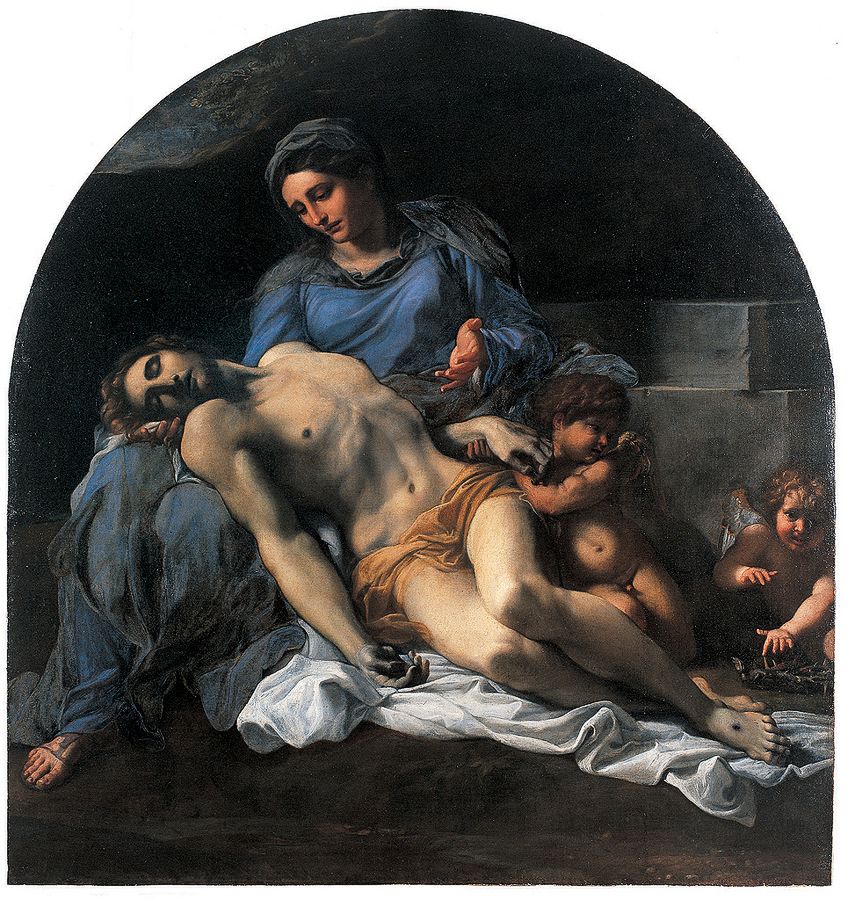 Pietà (1585) by Carracci;Annibale Carracci, Public domain, via Wikimedia Eatables
Pietà (1585) by Carracci;Annibale Carracci, Public domain, via Wikimedia Eatables
Michelangelo Merisi da Caravaggio (1571 – 1610)
Caravaggio was a revolutionary artist of his time, and lived a more conflicted lifestyle, being involved in numerous crimes. He started his artistic training in Mannerism in Rome, merely he somewhen moved away from this mode and adopted a more than naturalistic approach. He became a popular creative person due to his innovative style of painting and use of subject affair.
Caravaggio painted from the globe around him and would often incorporate everyday imagery with the sacred figures. In a fashion, he bridged a gap between the normalcy of life with the sacred. He made saints homo, and some sources refer to the concept of "spiritual populism", in which he fabricated sacred, religious art available to the ordinary man on the street.
The divine was non a far off platonic of perfection anymore, which was in line with what the Cosmic Church building wanted from art during the Counter-Reformation.
Many of the great examples of Caravaggio paintings include The Calling of Saint Matthew (1600), The Martyrdom of Saint Matthew (1600), Crucifixion of Saint Peter (1601), Expiry of the Virgin (1606), and the Flagellation of Christ (1607), among many others. You may find Caravaggio'south radical realism in his painting, Death of the Virgin (1606), which was criticized for its portrayal of Mother Mary. The dead virgin in this painting is Mother Mary, but the artist depicted her lifeless torso equally just another woman – one might call back that it is just another woman who died.
 Morte della Vergine('Death of a Virgin', 1606) past Caravaggio; Caravaggio, Public domain, via Wikimedia Commons
Morte della Vergine('Death of a Virgin', 1606) past Caravaggio; Caravaggio, Public domain, via Wikimedia Commons
Caravaggio emphasizes the naturalness of this composition with various elements, such as the simplicity of her clothing, her hands and feet appearing swollen, and the simplicity of the scene and men effectually her body mourning her. The only indication of her being a holy figure is the thin halo around her caput. Caravaggio opens the whole scene to the viewer in the forefront, with the diverse mourners seemingly creating a backdrop in the background, thus forcing the viewer to be there with the dead torso of Mother Mary.
Additionally, we meet the employ of stark contrast of dark and light in many of Caravaggio's paintings. His use of the chiaroscuro technique became a signature feature of his artworks. This too influenced many other artists around Europe, and became a phenomenon chosen Carravagism.
Artemisia Gentileschi (1593 – 1656)
Artemisia Gentileschi was a prominent female artist during the Baroque catamenia. She is remembered for her use of techniques like chiaroscuro, a close second to Caravaggio. She also portrayed many women from biblical stories, scenes of rape and various power struggles, equally well equally emphasizing the role of a woman within a man's world, equally the art world was mainly dominated past men at the time. Her scenes depicted the realism nosotros so often see from many Baroque masters.
Some of her popular works include Susanna and the Elders (1610), Danae (1612), and Judith Slaying Holofernes (c. 1620), which is a dynamic artwork and one likewise washed past Caravaggio. In Gentileschi's version of Judith Slaying Holofernes (c. 1620) we volition meet the artist focusing more on the women slaying the male figure, who is busy struggling while the 2 pivot him down and start beheading him.
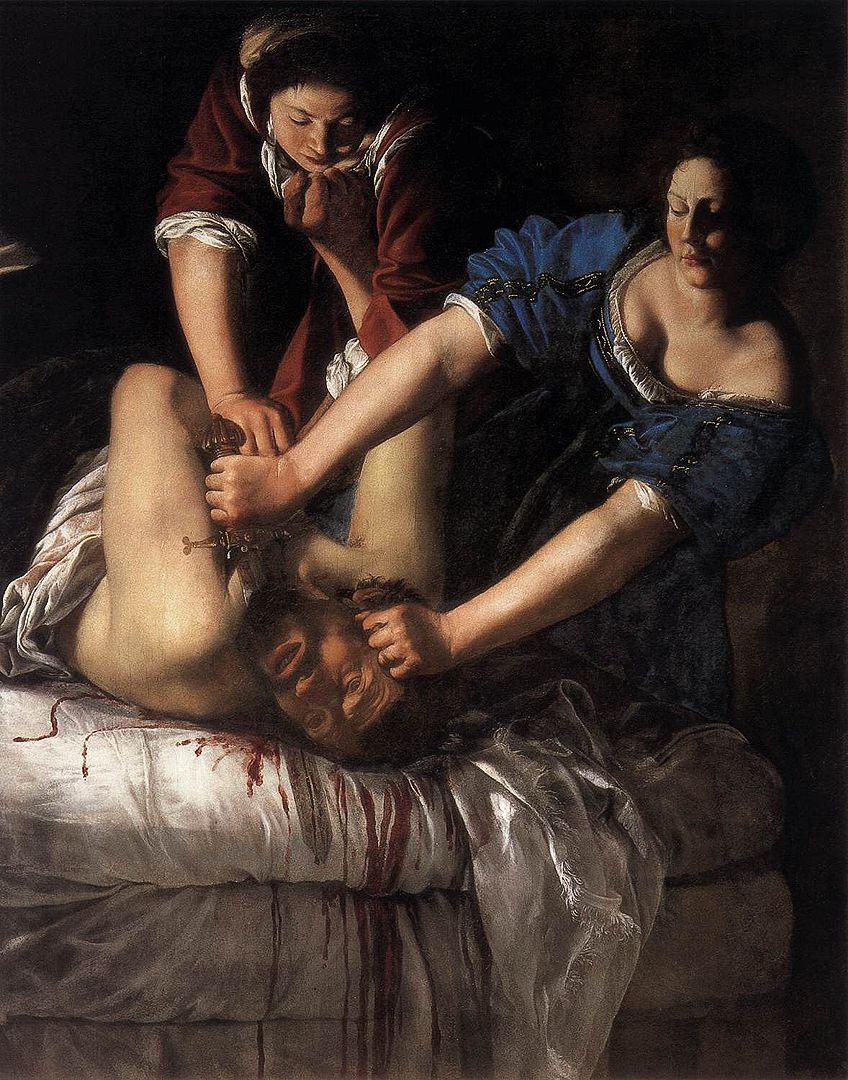 Giuditta che decapita Oloferne (' Judith Beheading Holofernes', 1611-1612) by Gentileschi;Artemisia Gentileschi, Public domain, via Wikimedia Commons
Giuditta che decapita Oloferne (' Judith Beheading Holofernes', 1611-1612) by Gentileschi;Artemisia Gentileschi, Public domain, via Wikimedia Commons
This composition takes place in the heat of the moment, and then to say, as we besides detect how the blood sprays out of the neck, making the whole scene all the more than emotionally intense and severe. She also used darker areas of color with the chiaroscuro technique in improver to a deep palette of colors.
Other aspects of this composition point to the power Gentileschi displayed as an artist herself, being able to portray her subject affair the fashion she wanted to. The tearing display of power and death in this painting also points to the underlying motivation for painting a scene similar this, as she was the victim of sexual assail equally a young woman.
Baroque Architecture
Bizarre architecture is characterized by ornate decorations, high ceilings decorated with frescos, and lavish ornament to draw viewers' attention and emotional reactions of awe. It is of import to note the role of the Jesuits in Baroque architecture.
The Jesuits were a religious order at the time of the Counter-Reformation and sought to create a new type of architecture to inspire the people and describe the majesty of the Catholic Church.
Giacomo Della Porta (1532 – 1602)
Baroque compages is believed to have started with the Church building of the Ges ù (1584) and the pioneering style of its façade, which was designed by Giacomo Della Porta, a sculptor and architect in Italia. Giacomo Della Porta was an important architect for the Baroque menstruum. He learnt from other great masters of art like Michelangelo, and was instructed past Giacomo Barozzi da Vignola (1507 – 1573), a leading Mannerist architect in Italia.
 Façade of Chiesa del Gesùin Rome, Italia, designed past Della Porta; I, Alejo2083, CC BY-SA 3.0, via Wikimedia Commons
Façade of Chiesa del Gesùin Rome, Italia, designed past Della Porta; I, Alejo2083, CC BY-SA 3.0, via Wikimedia Commons
The Church of the Ges ùwas synthetic for the Society of Jesus, likewise chosen the Jesuits. Della Porta worked alongside Vignola on this edifice, and although the advent of the façade was non every bit elaborate every bit the later Baroque buildings – nosotros can see it appears minimally decorated overall with only a concentration of architectural adornments near the entrance – information technology set the tone for the beginnings of Bizarre architecture.
Baroque Sculpture
At that place were many great sculptors during the Baroque period, but there was one artist who stood out among everyone else and laid the foundations of what sculpture was. Bizarre sculpture was made, every bit ordered past the Catholic Church, to create awe and inspire the mutual people.
Baroque sculpture was characterized by various features, namely its interactivity, as viewers were able to walk around the whole sculpture and view its completeness, which made its bulletin more impactful. It was likewise used in churches to accentuate architectural structures. Furthermore, sculptors were so skilled in their fine art they created works with extensive attending to item, from gender to the diaphanous nature of the fabric on the sculpted figure.
Giovanni Lorenzo Bernini (1598 – 1680)
This brings us to Giovanni Lorenzo Bernini, an architect and sculptor in Italian republic. He was predominantly a sculptor and has been compared by some scholars to possess the same importance that Shakespeare had for the globe of theater and literature.
Bernini was considered a prodigy during his early years, with many comparing him to Michelangelo.
Bernini's sculptures depicted the moment of action taking identify, which added to the intensity of the piece of work upon viewing information technology. His subject matter consisted of biblical and mythological scenes and figures, and nosotros can see examples of this in his sculptures like Aeneas, Anchises, and Ascanius (1619), The Rape of Proserpina (1621 – 1622), Apollo and Daphne(1622 – 1625), and David (1623 – 1624).
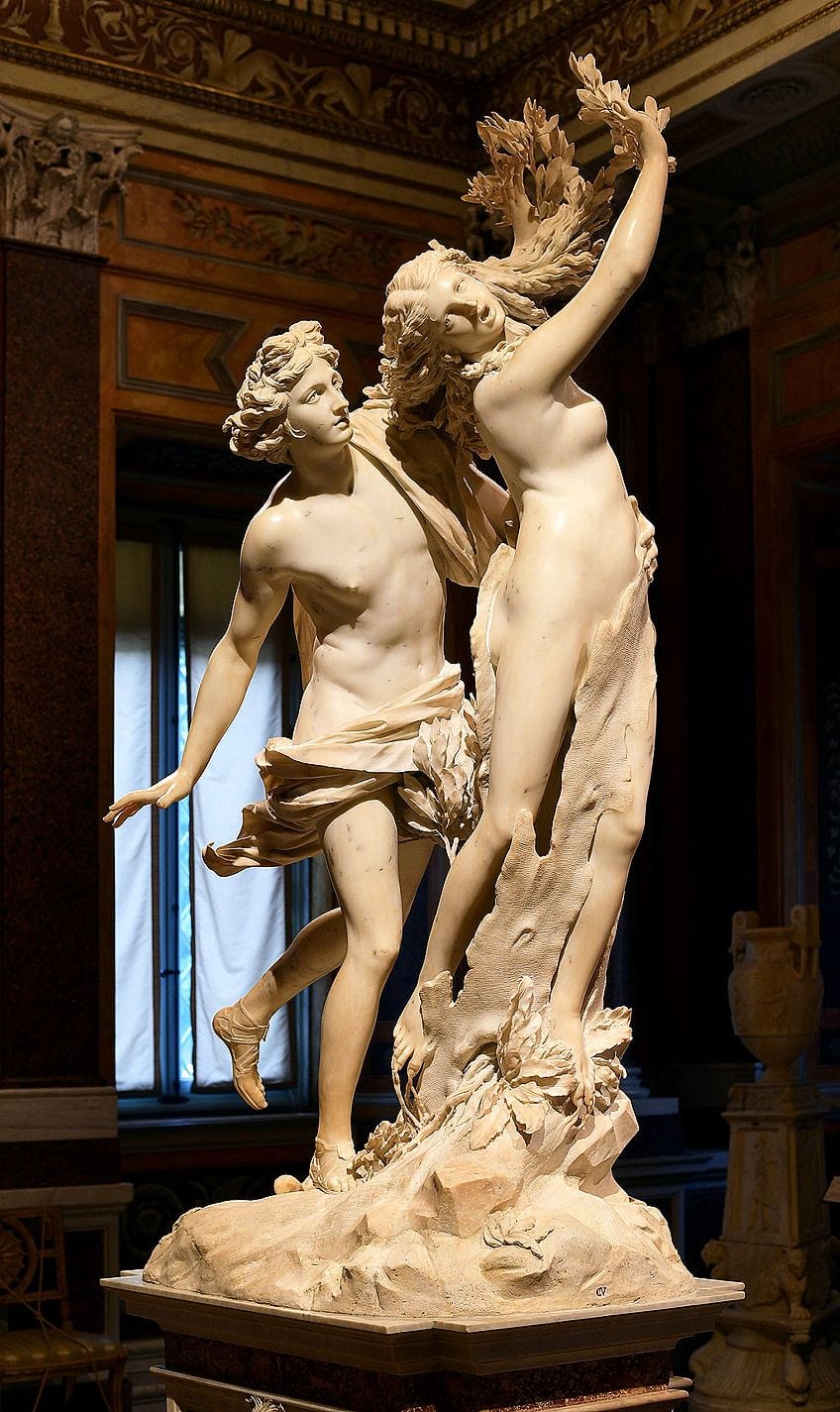 Apollo and Daphne (1622-1625) by Bernini; Gian Lorenzo Bernini, CC BY-SA 4.0, via Wikimedia Commons
Apollo and Daphne (1622-1625) by Bernini; Gian Lorenzo Bernini, CC BY-SA 4.0, via Wikimedia Commons
One of Bernini's greatest sculptures to appointment is the Ecstasy of Saint Teresa (1647 – 1652). Made of pure marble, it is housed in the Cornaro Chapel in Rome. The sculpture depicts Saint Teresa of Avila lying half-conscious on a deject with an angel. The angel is slightly elevated, side by side to her body on her correct, and just nearly to pierce her heart with a spear. The marble is carved in such a mode that makes the Saint appear as light as a feather floating on the cloud, which highlights the story Bernini is portraying hither.
Here, we come across Saint Teresa experiencing a deep moment of ecstasy. Information technology appears spiritual in nature, but Bernini also focused on the physical and sensual effects this experience gave the Saint. Nosotros see this in the fashion her body lies as well as her facial expression. Behind the central figures, we also notice what appears like rays of low-cal shining downward on the moment of pure elation.
When we look at the whole limerick, we will also detect the central figures are within a columned structure with two theater boxes on either side of the principal subject of the Saint and Angel. The theater boxes are directly reverse the other and contain sculptures of the Cornaro family.
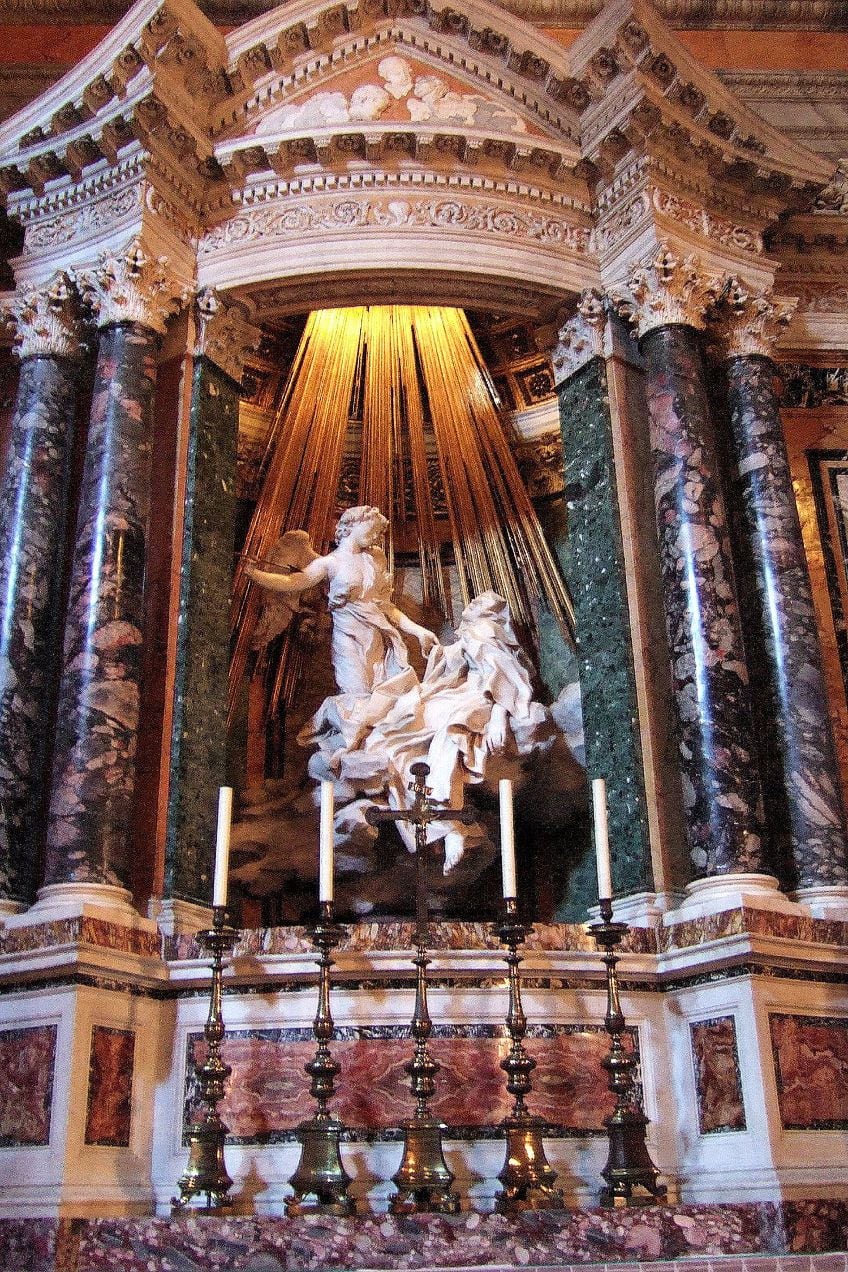 Trasfigurazione di santa Teresa('Ecstasy of St. Teresa', 1652) by Bernini;Gian Lorenzo Bernini, CC BY-SA 2.0, via Wikimedia Commons
Trasfigurazione di santa Teresa('Ecstasy of St. Teresa', 1652) by Bernini;Gian Lorenzo Bernini, CC BY-SA 2.0, via Wikimedia Commons
Other Famous Bizarre Painters
Below are other famous Baroque artists worth noting, especially artists that came from different European countries other than Italia.
Flemish Baroque Artists
Peter Paul Rubens (1577 – 1640) was an influential Flemish artist that created artworks with religious themes, including mythological scenes. His work varied from landscapes, portraits, altarpieces, and paintings. This Bizarre period creative person was known as giving northern fine art, specifically painting, a new perspective. He was influenced by artists like Titian and incorporated a diverseness of male and female person figures in the nude in his paintings.
Furthermore, his paintings depicted strong emotional vibrancy and are oft described as exuberant in style.
Some of his famous artworks include The Elevation of the Cross (1611), Massacre of the Innocents (1612), Prometheus Jump (1618), The Admiration of the Magi (1624), Venus and Adonis (1635), and The 3 Graces(1639), and the Return of the Peasants (1640), which depicts Ruben'due south dear of landscapes.
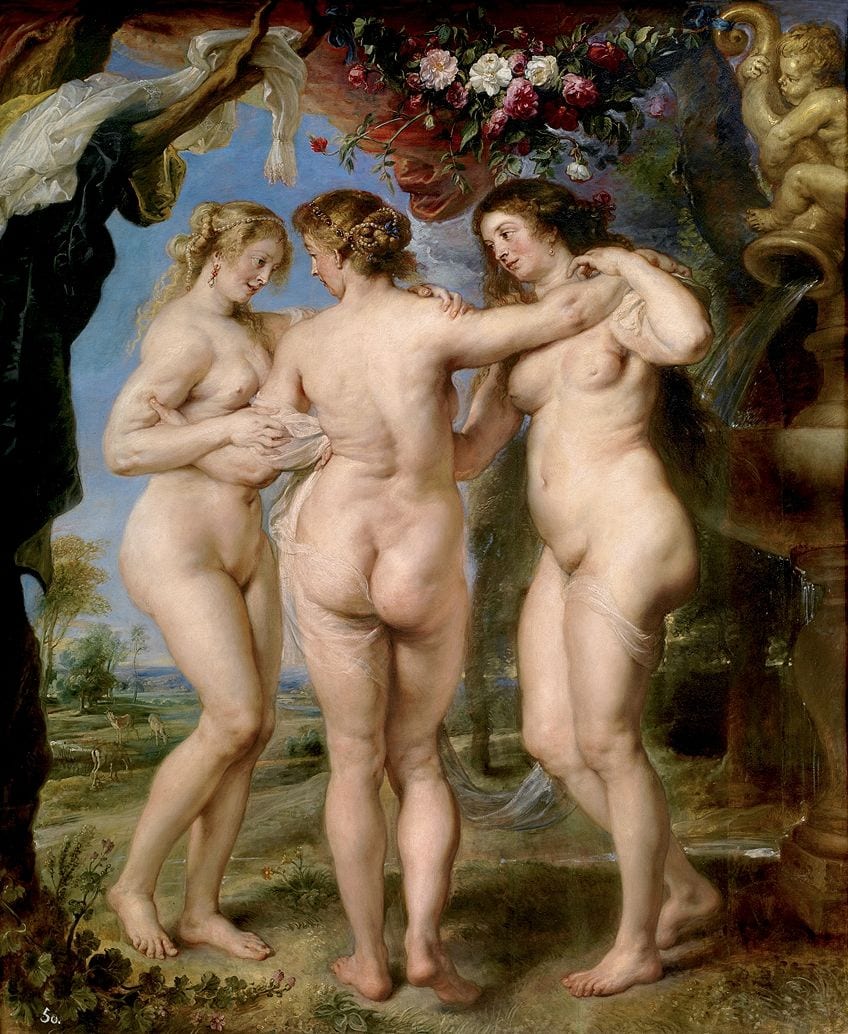 The Three Graces (c. 1635) by Rubens; Peter Paul Rubens, Public domain, via Wikimedia Commons
The Three Graces (c. 1635) by Rubens; Peter Paul Rubens, Public domain, via Wikimedia Commons
French Baroque Artists
Georges de La Tour (1593 – 1652) created artworks using stiff chiaroscuro techniques similar to Caravaggio. Even so, what made La Tour'due south paintings different was his simplified approach and rendering of figures. He is known for depicting scenes that announced by candlelight.
Where Caravaggio's paintings depict emotional intensity, La Tour's paintings describe an emotional stillness. His subject area matter was of religious figures and narratives. Examples of his artworks include The Penitent Magdalene (c. 1640), Joseph the Carpenter (1642), Nativity (1644), and The Newborn Christ (1645).
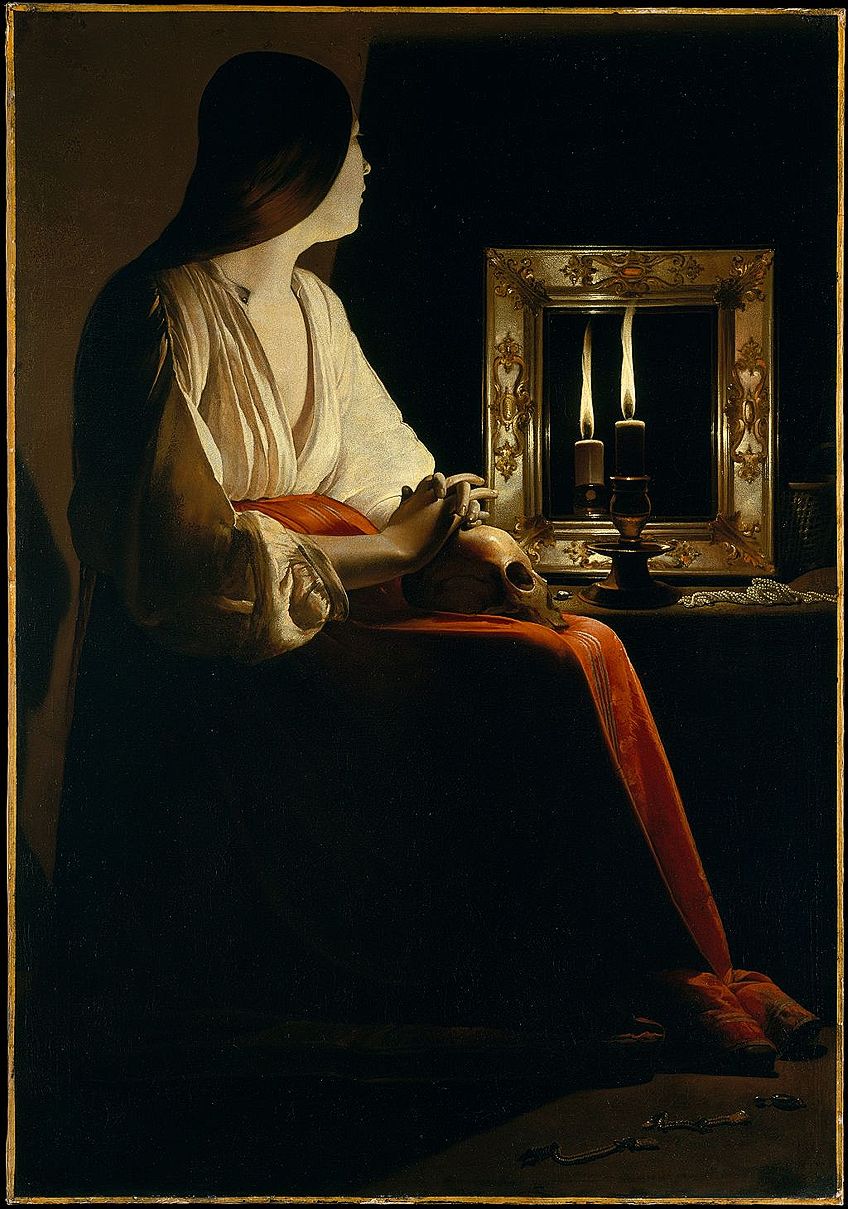 The Penitent Magdalene (c. 1640) by de la Tour;Georges de La Tour, Public domain, via Wikimedia Commons
The Penitent Magdalene (c. 1640) by de la Tour;Georges de La Tour, Public domain, via Wikimedia Commons
Spanish Baroque Artists
Diego Rodríquez de Silva y Velázquez (1599 – 1660) was a Spanish Baroque menstruation artist who likewise painted for Rex Philip IV's court, which led him to paint numerous portraits of court officials as well as of the Spanish royal family. He was well-known equally i of the pioneering portraiture artists of his fourth dimension. Many sources as well refer to him as the "the painter's painter" due to his all-encompassing attention to particular in his paintings. He often painted everyday scenes of people and nature.
Some of his famous artworks include The Supper at Emmaus (1618 – 1623), The Surrender of Breda (1635), Portrait of Juan de Pareja (1650), Portrait of Innocent X (1650), and Las Meninas (1656), the latter of which is ane of the most famous artworks by the artist due to the strategic rendering of compositional elements like space, colour, perspective, and line.
Information technology depicts Infanta Margarita, who was King Philip Four's daughter. She is surrounded by female person attendants with her in the center richly clad as royalty. We can too notice the artist depicting himself in the background while he is in the process of painting the scene.
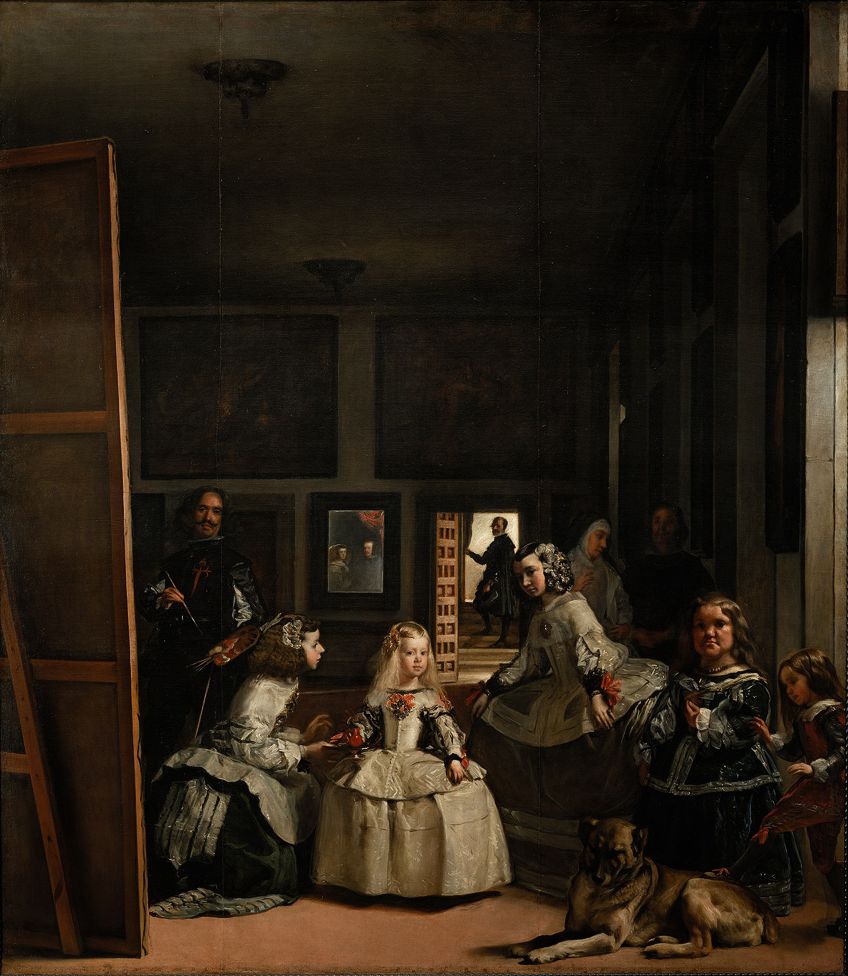 Las Meninas ('The Maids of Honour', 1656-1657) past Velázquez;Diego Velázquez, Public domain, via Wikimedia Eatables
Las Meninas ('The Maids of Honour', 1656-1657) past Velázquez;Diego Velázquez, Public domain, via Wikimedia Eatables
Dutch Bizarre Artists
Rembrandt Harmenszoon van Rijn (1606 – 1669) was i of the virtually influential and well-known Dutch painters, and to this twenty-four hour period he is remembered as an of import artist. This Dutch Bizarre menses artist produced many great artworks during his career, including the masterpiece, The Night Spotter (1642).
Van Rijn created unlike scenes of everyday life, landscapes, besides every bit religious and mythological subject area matter. Rembrandt's paintings are well-known to accept captured the abundance during the Dutch Golden Age, the catamenia during which he painted.
His paintings showed varied emotional states including a keen eye for detail while painting his scenes. He besides utilized techniques of lite and nighttime contrasts (chiaroscuro) and innovative means of handling his paint and brushstrokes, often using unlike textures.
Some of his famous paintings includeThe Anatomy Lesson of Dr. Nicholas Tulp (1632), Man in Oriental Costume(1632), The Night Watch (1642), Slaughtered Ox (1655), Jacob Blessing the Sons of Joseph (1656), andSelf-Portrait with 2 Circles (1660).
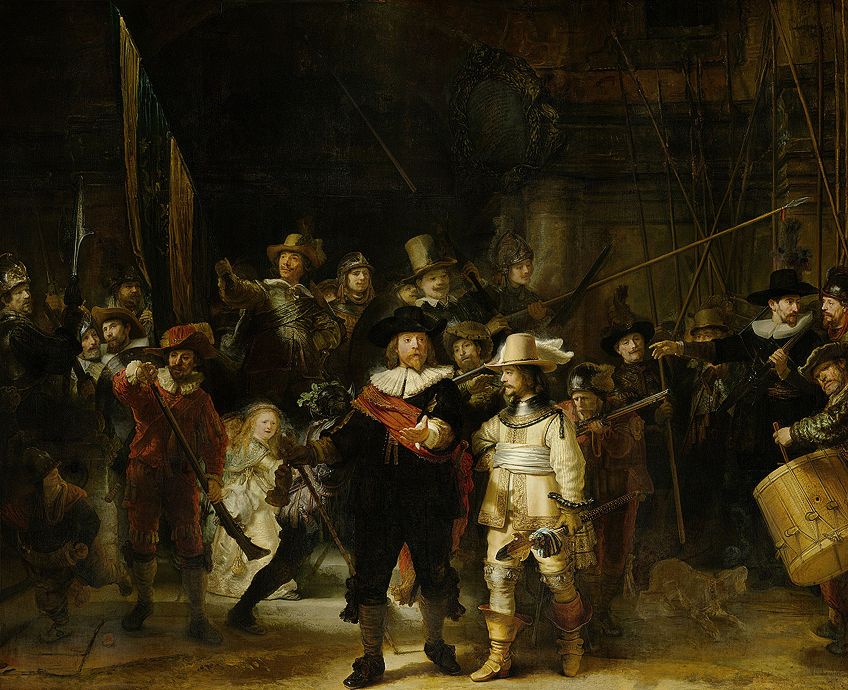 The Dark Watch (1642) past Rembrandt;Rembrandt, Public domain, via Wikimedia Commons
The Dark Watch (1642) past Rembrandt;Rembrandt, Public domain, via Wikimedia Commons
From Dark to Light: Bizarre and Rococo
The Bizarre period, which started in Rome, eventually evolved into what was chosen the Rococo menstruation, which started around 1702 until 1780 in France. The Rococo menses was a time during which art portrayed a sense of lightness every bit opposed to the darker portrayals we see from the Baroque period. What both art movements shared was the dramatic flair in their artworks and use of ornate decorations, seen in paintings, sculpture, and architecture.
Bizarre continues to alive on in the future with many Baroque period artists influencing other artists from the Rococo period, besides as subsequent art movements like Romanticism, Impressionism, and Post-Impressionism. Contemporary artists and architects like I.1000. Pei and Frank Gehry accept also used inspiration from Bernini'south structures.
Baroque art was an innovative art period led past many nifty artists of its time who sought to motion beyond the boundaries of what fine art was before. With a foundation in depicting the realness and naturalness of life and its people in combination with the sacred imagery of biblical and mythological figures, it brought the idealistic down to earth.
You tin also read our baroque art facts webstory.
Oftentimes Asked Questions
What Is Baroque Fine art?
Baroque art started during the belatedly 1500s into the early 1700s. Information technology was an fine art catamenia during the Counter-Reformation when the Catholic Church was in opposition to the Protestants, who had started the Reformation. As function of the reaction, the Cosmic Church wanted art to inspire the masses and leave them in awe of the magnificence and dazzler of not just the Church, only the power and majesty of the Biblical and mythological narratives portrayed through paintings, sculpture, and architecture.
What Characterized the Baroque Period?
The Bizarre period was characterized by using embellished and ornate decorations in paintings, sculpture, and architecture. Bizarre artists portrayed a heightened sense of emotion in their paintings – ofttimes a scene when the nigh activity would have identify. Furthermore, the Baroque period can be known to be theatrical while remaining true to the styles of classicism and naturalism. Many artists used new techniques to emphasize emotion, such aschiaroscuro, which explored light and dark contrasts.
When Was the Baroque Catamenia?
The Baroque menses started every bit an art movement later on the Renaissance and Mannerism fine art periods, and was followed by the Rococo art movement. Many artists during the Baroque catamenia turned away from the styles in Mannerism and were influenced by leading artists from the Renaissance period, frequently using the styles from the Loftier Renaissance to create what was known as Baroque art.
Source: https://artincontext.org/baroque-art/
0 Response to "What Genres of Art Were Popular in Northern Europe During the Baroque Period?"
Post a Comment